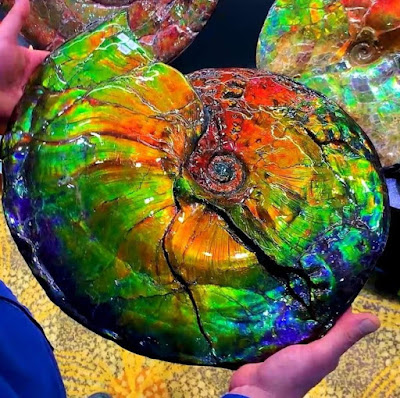
Ammolite: Gemstone with a Spectacular Flash of Iridescent Colors! A gigantic opalized ammonite fossil from southern Alberta, Canada.Photo: Rocks for the Spirit
The Rare Ammolite with a spectacular flash of iridescent colors!
Ammolite is an opal-like organic gemstone found primarily along the eastern slopes of the Rocky Mountains of North America. It is made of the fossilized shells of ammonites, which in turn are composed primarily of aragonite, the same mineral contained in nacre, with a microstructure inherited from the shell. It is one of few biogenic gemstones; others include amber and pearl.
The chemical composition of ammolite is variable, and aside from aragonite may include calcite, silica, pyrite, or other minerals. The shell itself may contain a number of trace elements, including: aluminium; barium; chromium; copper; iron; magnesium; manganese; strontium; titanium; and vanadium. Its crystallography is orthorhombic. Its hardness is 4.5–5.5, and its specific gravity is 2.60–2.85.

An iridescent opal-like play of color is shown in fine specimens, mostly in shades of green and red; all the spectral colors are possible, however. The iridescence is due to the microstructure of the aragonite: unlike most other gems, whose colors come from light absorption, the iridescent color of ammolite comes from interference with the light that rebounds from stacked layers of thin platelets that make up the aragonite.
Significant deposits of gem-quality ammolite are only found in the Bearpaw Formation that extends from Alberta to Saskatchewan in Canada and south to Montana in the USA.
The best grade of gem quality ammolite is along high energy river systems on the eastern slopes of the Rockies in southern Alberta. Most commercial mining operations have been conducted along the banks of the St. Mary River, in an area south of and between the town of Magrath and the city of Lethbridge.
The ammolite deposits are stratified into several layers:

The shallowest of these layers, named the “K Zone“, lies some 15 meters below the surface and extends 30 meters down. The ammolite within this layer is covered by siderite concretions and is usually cracked—this is the crush material. It is the most common and (generally speaking) the least valuable of ammolite. Beginning twenty meters below the crush material is the “Blue Zone“; ammolite from this zone, which extends 65 meters, is usually compressed with a thin layer of pyrite rather than siderite concretions. This is the sheet material; due to its depth it is rarely mined. It is also much less fractured, and therefore the more valuable type of ammolite.
Canadian ammonites are rare. The Canadian government considers them part of the “National Treasures of Canada”. For this reason, all ammonites must be inspected and registered by the Alberta provincial government. Each ammonite then receives a number and is entered in the provincial database. A cultural property export permit, with the name and address of the buyer, is required before any Canadian ammonite is allowed to leave the country.
Identifying Characteristics

Colors
Gemstone ammonite can be found in any color known in nature or the imagination of man. It can also have an infinite array of color combinations in every square centimeter. The higher grades will either have a very strong, bright single color, or contain a range of bright colors drawn from a color spectrum vaster than a rainbow. Lower grade gemstones will show less vibrant colors in a more limited range. Generally, red/green is more common than blue or purple, but there are certain hues, like crimson, violet and gold, that are very rare and in high demand.
IridescenceIridescence is the property that creates the incredible colors across the surface of ammolites. The surface of gem-quality fossil shells is composed of closely-packed, tabular crystals of aragonite, with their c-axis oriented vertical to the shell surface.
Chromatic ShiftThe color of ammolite depends on the angle of light and the viewer’s perspective. Sometimes, a chromatic shift occurs. (Sometimes this is subtle; sometimes this is spectacularly dramatic). Red will shift to green, green will shift to blue, etc. This shift is called dichromatic.

Rotational RangeSome material won’t show strong, vibrant colors through 360° of rotation. When these stones are rotated, the brightness decreases and darkens to black.
EnhancementsGems are sometimes treated with lacquer or Opticon fracture sealer for stabilization.